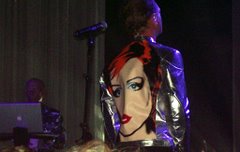Top Chef – Finale, Part One
 TELEVISION After a one month break, the four remaining chef-testants travel to Aspen for the final leg of their trek to be named Top Chef. Approaching the helium balloon that they’ll be boarding, Brian lets out a perfect gay gasp and grabs hold of bi-Hung’s arm. It’s nice to see the excitement and camaraderie. Taking in the fresh mountain air while heading to their final destination, they had to breathe deeply to take command of cooking fresh trout in the Frying Pan River Challenge. Guest judge Eric Ripert speaks with authority when telling them “good luck, you’re going to need it.”
TELEVISION After a one month break, the four remaining chef-testants travel to Aspen for the final leg of their trek to be named Top Chef. Approaching the helium balloon that they’ll be boarding, Brian lets out a perfect gay gasp and grabs hold of bi-Hung’s arm. It’s nice to see the excitement and camaraderie. Taking in the fresh mountain air while heading to their final destination, they had to breathe deeply to take command of cooking fresh trout in the Frying Pan River Challenge. Guest judge Eric Ripert speaks with authority when telling them “good luck, you’re going to need it.”
While rushing around, seafood expert Brian drops his fish on the ground and loses time starting over. He also makes a comment that trout is not considered seafood. I’ve not heard that before. As he’s floundering, Hung finishes seven minutes before everyone else. I first wondered if it would be too long for the dish to just sit there but as time ran out it became moot point when he realizes that he forgot to add lemon juice. He should have been a little more focused, especially during the judging when he mentions his error. He still came in second place above Brian, who served an accompanying salad unsalted and Dale, who added a dash too much cayenne pepper to the apple and fennel. Casey reeled in a winner as her trout was served with crisped skin, grapes and corn, and was told it had soul.
The Elimination Challenge takes place at a rodeo where they’ll have to prepare free-range elk for 45 cowboys and cowgirls. Brian dons his cowboy hat and tells Chef Tom that he’s adding everything but the kitchen sink to his dish. As we’ve seen before, Tom humorously just tilts his head questioningly. Padma too is wearing a cowboy hat and rings the triangle for all to come and get it. Though the judges all found Brian’s explanation of his dish to take longer to say than eat, the editors had fun putting it together and dissolving from one portion of his “Whiskey Braised Elk Shank with Horseradish Sour Cream Potato Puree with Pancetta Corn, Asparagus relish and Blackberry, Balsamic and Sage Brown Butter” to the other. It also hurt when he gave the judges a choice of Roquefort or gorgonzola cheese instead of presenting what he felt would be the better choice.
Casey served a mushroom-crusted loin of elk that she said was rare but Ripert thought it was under-cooked as to call it black and blue. But he went all out to say her accompanying smoky tomato butter was amazing. Gail agreed saying that this “one component” was good. Casey also served a puree of cauliflower that Tom didn’t like because of the bits of caramelized cauliflower she added to it.
Hung got caught in a lie. When told they would be serving elk, he said in his interview that elk is boring and he didn’t enjoy cooking it. (He also asked “what do cowboys eat besides baked beans, baked beans and baked beans?”) In front of the judges, he sang a different song saying he loved elk and had fun cooking it. I agree when they say he is technically (techniquely) good but it’s this kind of regular back pedaling and bullshitting the judges that keeps me from rooting for him.
Dale was right up front about having a backup plan when his goat cheese tart didn’t turn out because there was no cream cheese available to add to it. Anticipating disaster, he had prepared cauliflower and fingerling potatoes adding dried cherries and toasted pecans to them which completed his spiked elk loin with huckleberry-blueberry sauce plate. His honesty didn’t hurt as he told the judges that when the restaurant where he worked closed, he didn’t work for 1 ½ years before the competition but has found himself again since. Dale has the good karma thing going on too and it was in the air as he won the evening’s competition. Proving that bigger, or more, isn’t always better, Brian was sent packing for having too much happening. Part two of the finale airs next week and it looks to be anyone’s game.

































